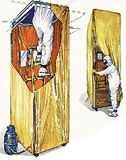The numbers are shocking. More people die each year in hospital accidents than in car accidents. According to the Centers for Disease Control, a patient has nearly a one in 20 chance of picking up a so-called nosocomial infection in a hospital. In round numbers, thats two million of the more than 36 million patients admitted to U.S. hospitals each year.
 |
| Streifel |
Sources attribute 2,000 to 3,000 of the deaths to "dirty" construction in or near operating hospitals. Poor hospital design, construction, operation and maintenance can be "deadly for immune-suppressed patients," says Judene Bartley, vice president of Epidemiology Consulting Services, Beverly Hills, Mich. Bartley and hospital environment specialist Andrew J. Streifel "wrote the book" on infection control in hospital design and construction.
It is a relatively new book. For until the late 90s, their entreaties to hospital owners to prevent "killer hospitals" largely fell on deaf ears, they claim.
 |
| Bartley |
The situation changed after young patients died from exposure to deadly mold spores. The lawsuits hit and that got everyones attention, says Bartley.
Streifel, who works in the Dept. of Environmental Health & Safety at the University of Minnesota, Minneapolis, calls infection control in hospitals "a national issue." He says it is made even more pressing due to the need for hospitals to prepare for emerging infectious diseases, including SARS, and bioterrorism in the post-9/11 world (see p. 2) .
"We spend billions and billions of dollars on [hospital] fire code management" and the effort is successful says Streifel. It has kept fire-related deaths to one to five a year, he adds. But Streifel says that "very little" by comparison, is spent for infection control, which sickens and kills people in exponentially greater numbers.
Things are changing, thanks in large part to unrelenting efforts of Streifel, Bartley and a few others. "Andy and I coined the phrase infection control risk assessment (ICRA)," says Bartley. The two then led the charge to develop procedures for ICRA and worked to get infection control into the Bible of hospital design and construction. In 2001, the provisions were added to the Guidelines for Design and Construction of Hospital and Health Care Facilities.
|
Chapter Five, on construction, begins with infection control. In the draft of the 2006 edition of the guidelines, released Nov. 1 for public comment, the chapter on infection control clarifies ICRA for greenfield projects versus construction near patients.
Though not a code, the guidelines have clout. They are published every five years by the American Institute of Architects Academy of Architecture for Health and the Facilities Guidelines Institute, with the help of the U.S. Dept. of Health and Human Services. Designers and builders follow them to help their hospitals pass muster with state regulatory agencies and the Joint Commission on Accreditation of Healthcare Organizations (JCAHO), which uses the guidelines for hospital inspections. Hospitals rely on accreditation for Medicare and Medicaid reimbursement, which accounts for about one-third of their revenue.
 |  |
| Containment. Dust control and worksite scrubbing only recently have become part of contract documents for health care projects. (Photo left courtesy of Skanska USA; right courtesy of Turner Construction) | |
New Chapter
As a result of Chapter Five, more hospitals are making it the contractors responsibility contractually to pay attention to the spread of dirt and dust and infiltration of moisture. This is especially critical at jobsites in or adjacent to operating hospitals, which account for more than two-thirds of hospital work. Bartley says the same guidelines that apply to acute-care facilities apply to ambulatory and long term care facilities. The risks to the patients are the same, she says.
A beneficial side effect of hospital infection control is that tools written for design and construction of health care facilities can be adapted for other building types, says Streifel. That can aid in the prevention of sick building syndrome in general, he says.
Though the cost of infection control may scare off some owners at first, it is minimal, in the long run, sources say. Mark Hayden, a senior project manager for Community Hospitals of Indianapolis, says infection control typically adds under 1% to the cost...
uring surgery recently in a Northeast hospital, the waterlogged ceiling of the operating room came tumbling down, complete with a bucket full of dirty water from a leaky roof. Miraculously, the patient did not die. But every year, nearly 90,000 others in the U.S. alone are not so lucky. They succumb to infections they pick up in the hospital.
